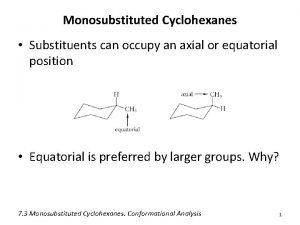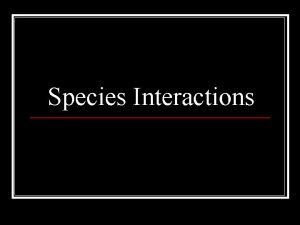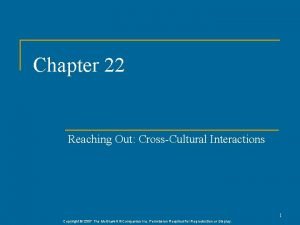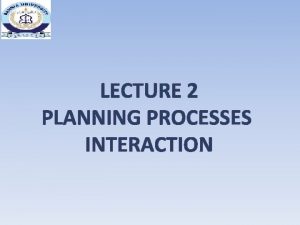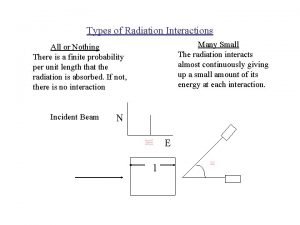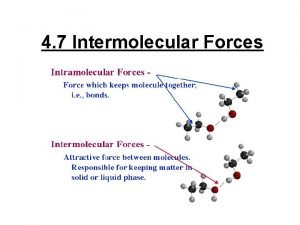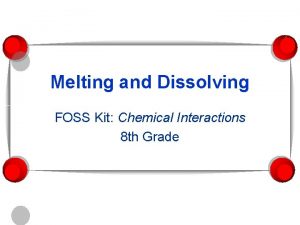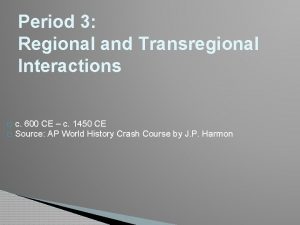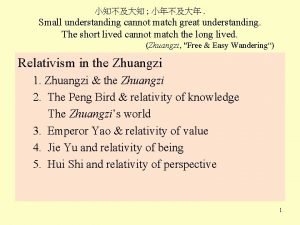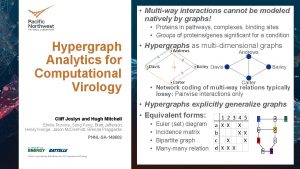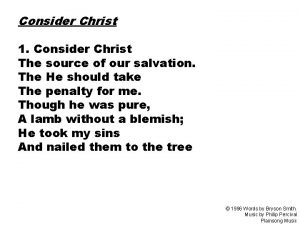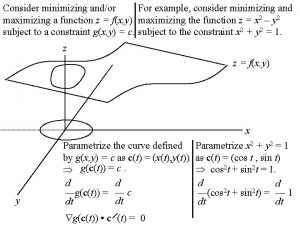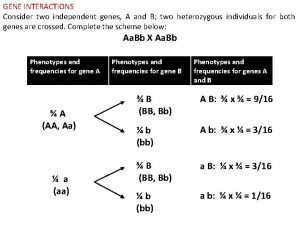Understanding that we cannot consider interactions as if

































- Slides: 33

Understanding that we cannot consider interactions as if they occur individually and independently, we can move to consider the ways in which ecologists study communities, and what we have learned about them… Community Ecology – Multi-species communities What is a community? Ricklefs’ definition: A community is “an association of interacting populations, usually defined by the nature of their interaction or the place in which they live. ”

Are communities like ‘super-organisms’, the species bound to each other by their interactions, or Are communities associations of species assembled by coincidence, and with species independent of each others’ presence and absence? The first view is sometimes called a closed community. The idea was developed in the 1920 s by a plant ecologist named F. E. Clements. He even coined the term ‘superorganism’ to describe it. The second view is called an open community. This was proposed by H. A. Gleason.

The implications of these two views of community structure are distinct, and allow us to assess whether one view works better than the other. The organismal community suggests that only particular groups of species should be found together, and that the boundaries of communities should sharply divide one group of species from another. This is almost a common sense view. Foresters talk about particular kinds of forests, defining them by the most common species: oak-hickory forests or oak-maple forests that dominate around here, pinyon pine or ponderosa pine forests in the Rockies and the west. Tall grass prairies are dominated by Andropogon gerardii, the characteristic species of the community.

Oak-hickory forest

Andropogon gerardii Tall grass prairie

Gleason’s view, of an open community comprised of ‘individualistic’ species suggests that community boundaries should be indistinct, that there may well be species substitutions in what we might describe as an oak-hickory forest just because those species are the most common ones in it. As well, when we look at the boundaries of distributions of species, those boundaries should not be linked. The boundaries are transitions between one habitat/ community and another, called ecotones. They are usually quite sharply evident. Here are some examples:

farm field to forest to grassland There is a transition in each case, though it may not be evident from the photograph. Consider the picture on the right. It isn’t evident from the picture that the soil beneath the grassland is a serpentine soil, with much different nutrients than beneath the forest.

Here’s the distribution of species and soil minerals from forest to serpentine barren in northern California There is good reason why some plant species can’t grow on serpentine soil. Both nickel and chromium are at much higher concentration in serpentine soil, and both tend to be toxic to plants that lack tolerance adaptations.

Clements’ organismal community concept suggests clear and relatively sharp community boundaries. Are ecotones always clear and sharp? No! Eastern deciduous forest as a whole has relatively sharp transitions to boreal forest to the north (due to cold), to open grassland to the west (due to limits on rainfall), to firetolerant pine forests to the south, and to ocean on the east. However, eastern deciduous forest is not ‘monolithic’. There are different species dominant, and different component species in different parts of the eastern deciduous forest. This sounds more like Gleason’s view, not only described as open, but as the basis of the continuum concept for communities. We can draw logical predictions from the two views:

Here is the way these two views compare in terms of theoretical distributions of component species of communities: Where are the clear margins of communities here?

Here is what Whittaker found along mountainsides in Oregon (the Siskyou Mts. ) and in the Santa Catalina Mts. of Arizona/California. Each line represents the distribution of a single species. Are there any signs of organismal interdependence and correlation in distribution limits among species?

The evidence we have points generally to the open, individualistic view of living communities. However, there is another way to learn about communities: study of the fossil record they leave behind. Trees (and other plants) that are wind pollinated leave behind evidence of their presence in the form of pollen grains. By aging segments of sediment cores (usually taken from the bottom of lakes) and identifying the types of pollen present in these segments, the component species in communities at different times in the past can be learned. In northern temperate North America, we can see what happened to communities as the glaciers receded northward over the 15, 000 years since the last (Wisconsin) ice age (glaciation).

In southwestern Ontario 10, 000 years ago, the forest was dominated by white pine… Pinus strobus eastern white pine There was no hemlock or hickory in those forests. But, by 5, 000 years ago, with the gradual recession of the glacial edge northwards, hemlock and hickory had migrated northward from their glacial refuge from the southeastern U. S. White pine remained a component of the community.

Tsuga canadensis eastern hemlock Carya glabra pignut hickory These post-glacial migrations tell us two things: 1. The boundaries of communities shift continuously in response to environmental conditions. 2. There was no necessary community integrity involving all, or even most of the species that now comprise a recognized community during post-glacial migration.

There is much more information about the northward migration. For example, some species basically moved straight northward. Others moved back into Canada by way of the Atlantic provinces and eastern Quebec. Still others migrated all the way around the Great Lakes, re-entering Canada a little west of Lake Superior. What had been a community before the Wisconsin glaciation fragmented for the duration of the glaciation and migrated separately northward as the glaciers receded. All this does not suggest Clements’ organismal community.

The ‘opposite side of the coin’ provides the same sort of evidence against Clement’s organismal community. Here, from your text (Fig. 21. 7) is the very messy set of distributions of tree species co-occurring in forests of eastern Kentucky. There are 12 different outlines overlapping in the diagram, but, with the exception of some similarity in range limits along the eastern slope of the Appalachian Mts. And in southern Louisiana, there is no apparent pattern.

The change in community structure and composition following glaciation occurred quite slowly. Communities also change over much shorter times. Communities may be altered by disturbances (fire, hurricane, etc. ). Following the disturbance, they recover. The process of change that occurs in recovery is called secondary succession. Communities also develop where new, never-before occupied space becomes available (e. g. by volcanic formation of a new island, like Karakatau. This process is called primary succession, since this is the development and succession of a first community on the site.

For Krakatau, a previous volcanic island exploded on August 27, 1883. What remained was, in effect, a new island, devoid of life, with a surface made up of volcanic ash. The new island, now called Rakata, wasn’t static. It, too, was volcanic and grew to a much larger size. It still is not very stable, and there are frequent rockfalls down one side of the island.

Ecologists rapidly recognized the value of studying how Krakatau recovered. Within 3 years there were 24 plant species recorded on the new island. 10 of them were dispersed to the island by the sea (e. g. coconuts), almost all the remainder were wind dispersed – blown from nearby sources Sumatra and Java. One was animal dispersed. By the 1920 s, there was a closed forest on the island, and initial colonists had been marginalized. With the forests came forest-dwelling animals (birds, bats), and with them came more animal dispersed seeds.

This is the most remarkable, well-studied primary succession. There are many more studies of secondary succession.

For example, Bob M’Closkey followed the secondary succession at Ojibway Prairie after a managed fire. In grassland, fire is an important and valuable management tool. Before humans began breaking prairie for agriculture, fires were a ‘regular’ phenomenon. Spring thunder storms started fires in the litter (the dry, dead, grasses from previous years). That released nutrients, raised the temperature of surface soil, and increased germination and growth of the plants. Now, to prevent forest from taking over at Ojibway, there is an established program that burns different parts of the prairie each year.

Ojibway Prairie before a burn, and what the fire looks like Since nutrients, seeds, and some species with protected structures below ground are already there, secondary succession proceeds much faster than primary succession.

What is the succession like after an intense (forest) fire that clears the space down to the soil surface… First – a grassland made up (mostly) of annuals, then, within a year or two, some flowering plants like annual sunflowers. This phase lasts 3 -4 years. Second – an old field of perennial grasses and flowering plants like goldenrods, asters, coneflowers. This phase lasts from around 4 years to about 10 years after the fire. Third – a shrub phase that lasts from 10 -20 years. Typical shrubs are sumacs, dogwoods, locust trees. Fourth – the entry and development of the trees of a mature forest, e. g. oaks and maples.

Here are photos from your text showing the succession following a forest fire in an oak-hornbeam forest in southern Poland…time in years 7 15 30 95 150

Succession (whether primary or secondary) leads eventually to what is called a climax community. The climax is the end point of a successional sequence like the one indicated to follow a forest fire. Clements recognized 14 climax communities in North America: • 2 types of grassland: prairie & tundra • 3 types of shrub: sagebrush, desert shrub, chapparal • 9 types of forest: beech-oak etc.

A short summary of succession: Species comprising the early stages of succession generally have a high capacity for dispersal (only they can get to the new area rapidly). As the community matures, the ratio of biomass to productivity (B/P) increases. Body size and the increasing presence of woody tissue increase biomass, but, while the photosynthetic area (area of leaves) increases, it doesn’t keep pace. Climax species are typically more shade tolerant, grow more slowly (see above), and disperse less widely (K-strategists, larger seed size) than the species they replace.

Diversity generally increases through succession, but the highest level is frequently achieved only partway through the sequence. Why? Because part way through, the species of early successional stages are still ‘hanging on’, while species of later succession have already appeared. As succession approaches closer to climax, those early successional species are lost.

Do we know much about the mechanism of succession? There are two ways that species modify their environments leading to succession: 1. Facilitation Species change environmental conditions in ways that support the colonization and establishment of later arrivals. One example – trees of the locust family have root nodules that support nitrogen-fixing bacteria (Rhizobium). The increased nitrogen supports the growth of species that require higher soil nitrogen.

2. Inhibition Here one species prevents others from becoming established. This is not frequently by means of allelopathy (suppression by chemicals leached into the soil from leaves or roots, e. g. the California sage you’ve seen before). Rather, a dominant species may block light from reaching smaller, younger plants, so that they die. Their roots may compete very strongly for nutrients, and deny them to other species. Oaks are dominant in many forest communities for both these reasons.

To introduce ideas about diversity (anticipating the next lecture), it is important to recognize the way in which interactions among species can influence/determine the number of species in a community. Typically, successionally advanced communities are at least moderately diverse. There are very few (if any) communities built from one or more food chains. Top predator Carnivore Herbivore Plant

Instead, each trophic level, and each species in a level, usually has multiple food sources (species below it). The result is termed a food web. You’ve already seen the effect of a keystone predator. However, it is virtually the only predator in its community (along the Pacific coast of Washington). In a seemingly similar community from further south (the Gulf of California), there is a diversity of intermediate predators and a large diversity of herbivores.

The more complex the food web (indicated by the number of links) the more diverse the community and, by controversial argument, the more stable the community. You can think of the basis of the argument in terms of available alternatives for any species. A species can persist, even when one food source goes locally extinct, by using alternative resources. However, the number of species and the number of links do not necessarily increase in parallel. Here’s the example from your text…

 Battlefield macbeth
Battlefield macbeth You can t manage what you don t measure
You can t manage what you don t measure If you cant measure it you can't manage it
If you cant measure it you can't manage it If you can’t measure it, you can’t improve it
If you can’t measure it, you can’t improve it Tôn thất thuyết là ai
Tôn thất thuyết là ai Phân độ lown
Phân độ lown Chiến lược kinh doanh quốc tế của walmart
Chiến lược kinh doanh quốc tế của walmart Gây tê cơ vuông thắt lưng
Gây tê cơ vuông thắt lưng Block nhĩ thất độ 2 type 1
Block nhĩ thất độ 2 type 1 Tìm độ lớn thật của tam giác abc
Tìm độ lớn thật của tam giác abc Sau thất bại ở hồ điển triệt
Sau thất bại ở hồ điển triệt Thể thơ truyền thống
Thể thơ truyền thống Con hãy đưa tay khi thấy người vấp ngã
Con hãy đưa tay khi thấy người vấp ngã Thơ thất ngôn tứ tuyệt đường luật
Thơ thất ngôn tứ tuyệt đường luật Beri beri
Beri beri Diaxial interactions
Diaxial interactions Nervous interactions with other systems
Nervous interactions with other systems Cape buffalo and cattle egrets relationship
Cape buffalo and cattle egrets relationship Interactions in the environment grade 7
Interactions in the environment grade 7 Sertaline
Sertaline Adelphoparasitism
Adelphoparasitism Unit 5 ecology
Unit 5 ecology Chapter 22 reaching out cross-cultural interactions
Chapter 22 reaching out cross-cultural interactions Erleada mechanism of action
Erleada mechanism of action Function of digestive tract
Function of digestive tract Project management process interactions
Project management process interactions Flocabulary photosynthesis read and respond answers
Flocabulary photosynthesis read and respond answers Types of interactions
Types of interactions Type of mechanical waves
Type of mechanical waves Contractionary monetary policy
Contractionary monetary policy Intramolecular forces
Intramolecular forces Foss chemical interactions
Foss chemical interactions Modular product architecture example
Modular product architecture example Regional and transregional interactions
Regional and transregional interactions















